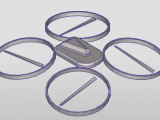The four-wing UAV is a new generation of drones that has been developed in recent years. Its features are light weight, fast speed, and instant silence. It can be used in military, agricultural, fire fighting and other fields. Many teams have made corresponding breakthroughs in the development of four-wing UAVs, and their update iteration cycles have been shortened. It is believed that the flight technology of the four-wing UAV will become more mature in the future.
In the early days, the analysis of drones was mainly through the field test flight to check the design effect. On the one hand, the test flight cycle is long, the number of times is high, the cost is high, and the field test flight is affected by various environmental conditions. The data analysis and improvement work after the flight test is not very intuitive; on the other hand, with the rapid development of CAE technology, such as Ansys software Strong versatility and high calculation accuracy, some large aircraft manufacturing companies have begun to use finite element software, such as the establishment of “UAV Dynamic Lab” to simulate the field test flight to reduce design costs.
Since the four-wing UAV uses a large number of thin-walled structures, the model can be simplified in the finite element analysis. Considering the structural symmetry, the model used in the design calculation should mainly consider the dynamics of the load during the movement of the blade rotating body. response. Prior to this, the model was statically analyzed and the model was imported into the simright simulator as shown below.

According to the weight of the model, the gravity acceleration is loaded in the Simulator, as shown in the figure below.

In addition, added the fixed constraint at appropriate position of the model, such as blade center constraint, blade holder and fuselage contact point constraint, given material property and submitted to the solution, as shown in the following figure. 
It can be seen from the stress cloud diagram that the stress is concentrated near the contact point between the blade holder and the fuselage, so the four-wing unmanned body is the most prone to breakage. These four contact points should be considered in the design. And welding materials to ensure the safety of the design.

Click to view item


